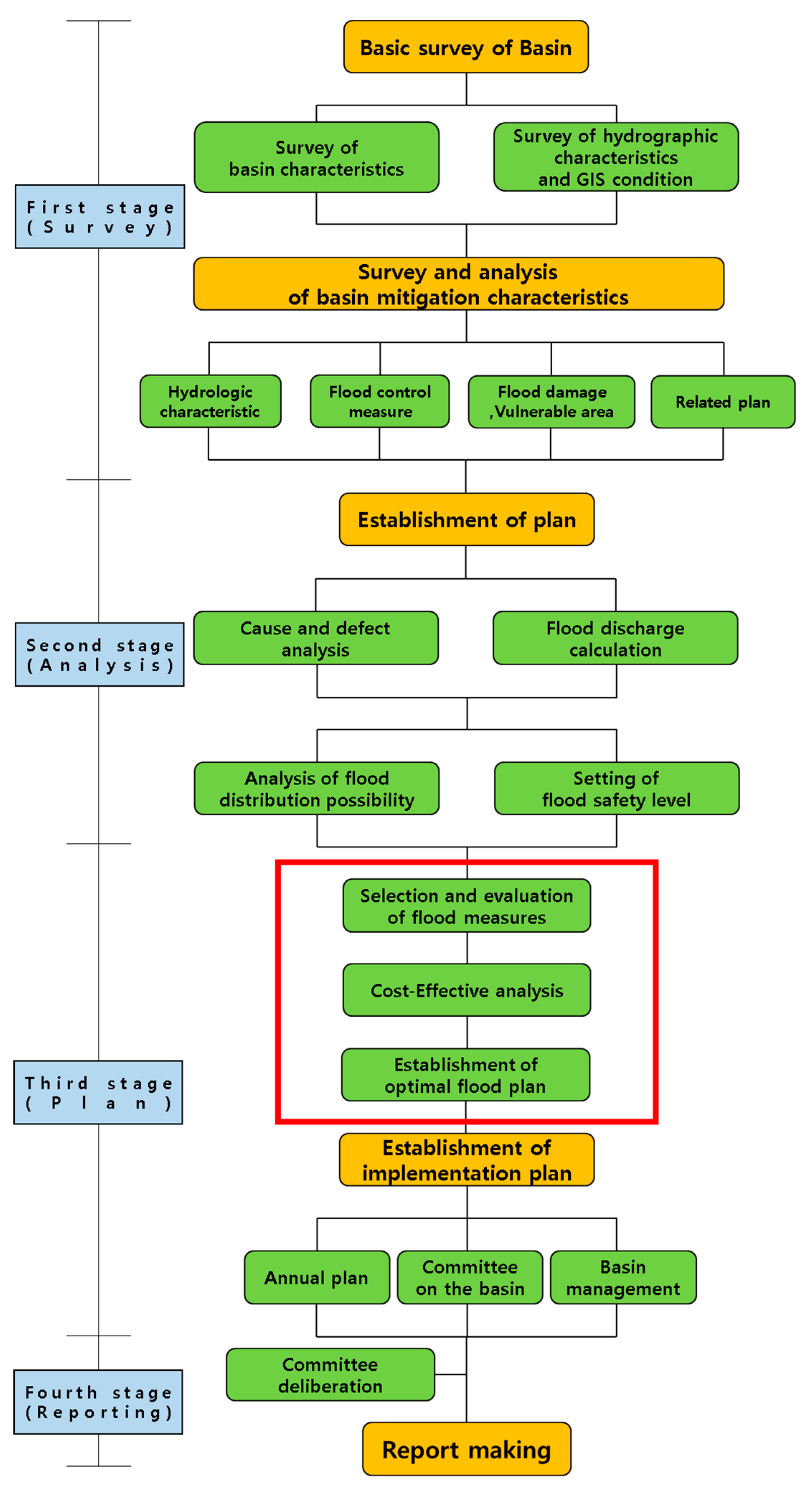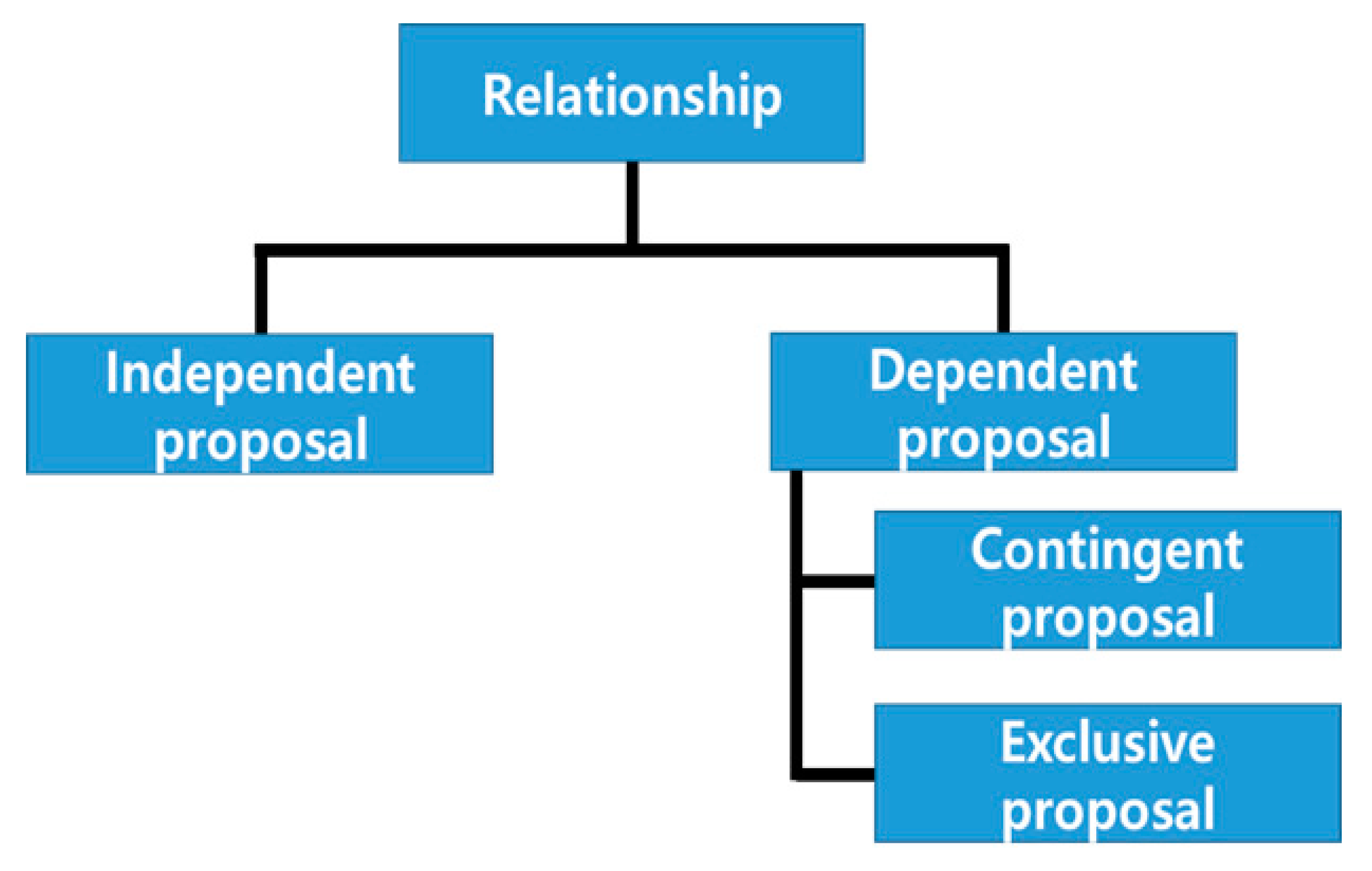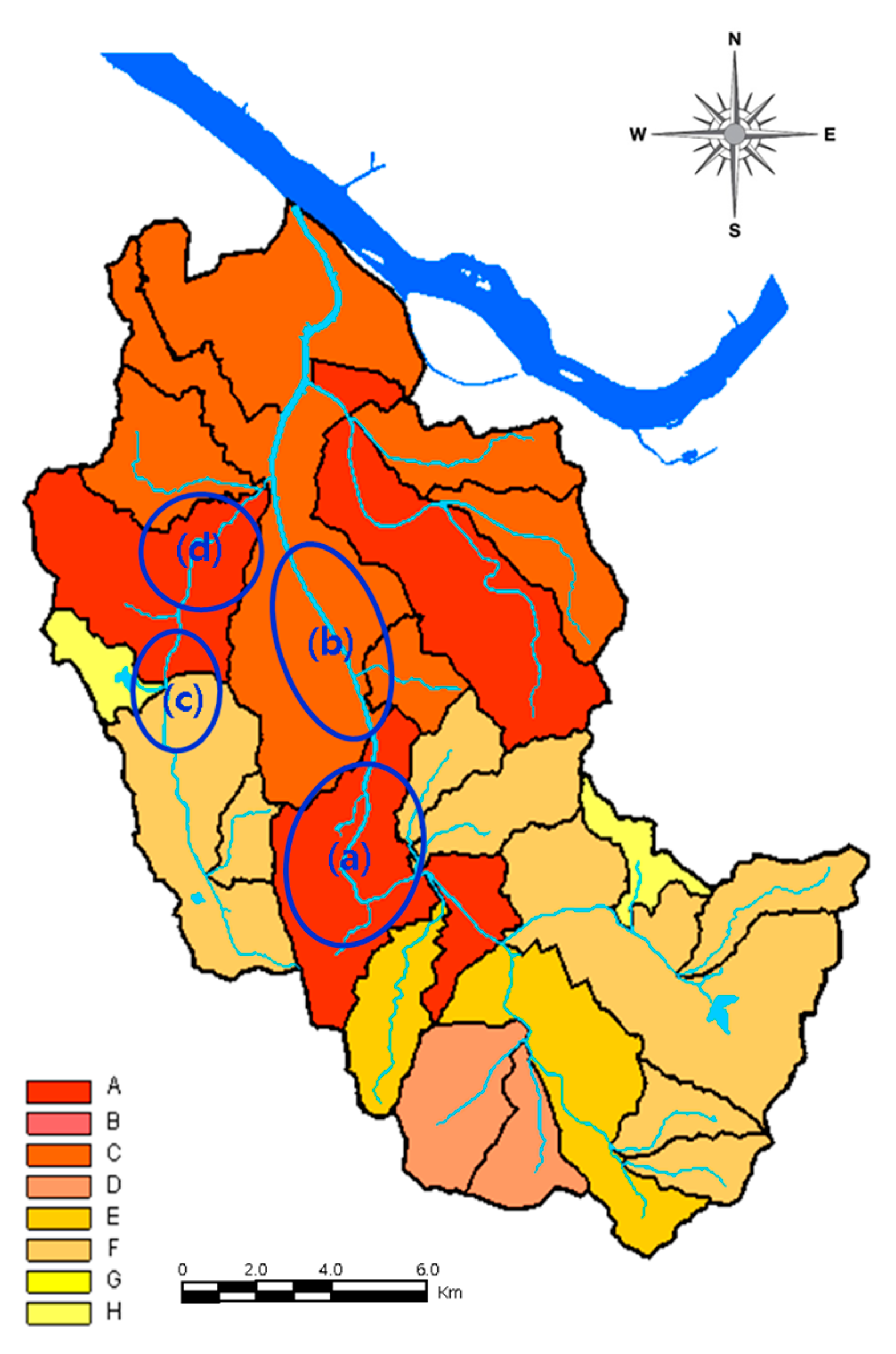Climate change leads to changing precipitation patterns and frequent flood damages. In the Korean peninsula, there has been on increasing frequency of extreme rainfall events including typhoons localized heavy rainfalls that continue for a relatively long-term period [
1]. In addition, rapid urbanization causes an increase in runoff, which results to flood, by growth of impermeability layers. This finally causes the growing potential of flood damages. Thus, establishing a flood prevention plan that properly reflects basin characteristics to prevent the flood damages is needed. In Korea, there are ongoing efforts to formulate the plan based on the “Comprehensive Flood Prevention Plan for river Basin” (‘CFPPB’). The CFPPB takes an expansive approach for the basin operation by relating the natural and artificial structures (dams, detention pond, flood control reservoir, flood way, etc) that can restrain flood flows, aiming to strengthen the basin’s flood prevention capability (CFPPB for Anyangcheon River Basin, 2005). The CFPPB is composed of four stages in total (survey, analysis, planning, and reporting). Among them, the planning stage is used to select structural measures for a river basin. However, this depends on hydrologists’ ability, because of lacking clear criteria for the selection and combination of structural measures. For this reason, the options that the Comprehensive Plan provides for structural measures are in question to serve as an objective foundation. This study aims to raise the objectivity of the process to select the structural measures by applying classification models for flood prevention and a method to combine the relation between the measures. There has been active research on selecting flood prevention measures. Chen et al. [
2] applied the fuzzy model when selecting the measures. Lee et al. [
3] used the analytic hierarchy process and the contingent valuation method to evaluate the measures and get priorities for investment. The developed model suggested the possibility that it could be applied to a variety of areas. However, study show that more verification is needed when it comes to calculating weights through Fuzzy model. Nocker et al. [
4] suggested that the Benefit–Cost Analysis Method can be useful for the selection, while Levy et al. [
5] applied a Multi-Criteria Decision Support System (MCDSS) to establish emergency measures for flood damages. It has been analyzed that MCDSS facilitates the process of information delivery, increases transparency in decision making, and improves communication among the parties involved in emergency management. Gupta [
6] reviewed flood defense measures established after heavy rain damage in Mumbai, India, in 2005. The paper suggested that in order to defend against urban flooding, structural and non-structural measures must be carried out at the same time and, among other things, the importance of the pump system and the water supply system is given in the study. Byeon et al. [
7] used the Support Vector Machine to develop decision-making models to classify the measures and applied them to actual basins for evaluation. More verification is needed, but the results of the assessment show that the proposed method is a systematic and objective. Lee et al. [
8] applied a range of factors when evaluating the measures and suggesting the priorities for the investment between them. However, the application of the methodology in practice indicated that it was necessary to apply the detailed changes to the characteristics of the area. Based on benefit–cost analysis and probability analysis, Heidari [
9] identified the types and scales of the measures to establish an optimal flood prevention plan for a target basin. Yeo et al. [
10] evaluated the measures to determine the priorities and optimal measure using the analytic hierarchy process and the utility function by the characteristics of evaluation criteria. Through the research, they developed a model that could evaluate a business on a single, consistent basis. Nevertheless, study show that it was necessary to ensure that the assessment factors and weights fit the purpose of the project to be carried out. Zhou et al. [
11] analyzed whether the diversification of the measures has an impact on reducing flood damages Yazdi et al. [
12] applied an optimization method based on a simulation when selecting the measures for a basin, and the optimal size of the combination was calculated by applying the Pareto method to compose combinations. The research shows that economically efficient measures can be selected by using the proposed method. Alferi et al. [
13] conducted a flood risk assessment throughout the whole Europe area and emphasized the importance of measures that reduce the impact of flooding, rather than those that directly defend against flooding. Rahman et al. [
14] assessed the seven defense measures on four criteria to determine their importance. However, there was problem with the weight of each evaluation factors that caused a change of rank. Hino et al. [
15] evaluated risk based flood defense alternatives and selected the measure for the target basin using the result of risk analysis. However, the analysis identified significant impacts from two factors (climate change influencing future river flows, and socioeconomic change influencing development in the floodplain). Scionti et al. [
16] chose the optimum flood defense measures after assessing those based on the scenario. Taseff et al. [
17] suggested a new approach to establish an optimal flood prevention plan under physical and economical limitations.
In previous studies, when selecting candidates for structural flood defense measures to the basin, the alternatives measures were proposed from the existing report or selected in the established flood defense measures. In addition, some studies randomly selected the defenses by the author without criteria. Although there have been studies to establish the optimal size of a combination, there is no method for making combinations. Studies still used establishing all the combinations and comparing the those. This method consumes a lot of time and money for evaluating a lot of union. Therefore, in this study, the candidates of flood defense measures were selected using the characteristics of the basin and vulnerability of flood risk, and the methodology of forming the combination through the relationship between the defense alternatives was proposed. Through this proposed methodology, an objective method was presented in selecting candidates and unlike the previous method, it was able to organize and evaluate the composition of the cooperative plan efficiently. It is believed that this study will solve subjectivity in the selection of measures, well as used to develop defense plans through a systematic process.












